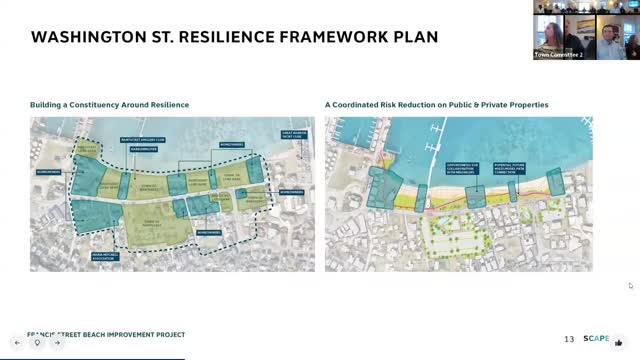Washington Street project sparks debate over community impact and future mobility plans
January 14, 2025 | Nantucket County, Massachusetts
This article was created by AI summarizing key points discussed. AI makes mistakes, so for full details and context, please refer to the video of the full meeting. Please report any errors so we can fix them. Report an error »

The Nantucket Town-County government meeting on January 10, 2025, focused heavily on the future of Washington Street, with discussions centering on the integration of utility improvements and community considerations into the ongoing planning process.
Key among the discussions was the need for clear communication regarding the proposed improvements to Washington Street. Officials emphasized the importance of including statements in the planning documents that outline how future enhancements will not disrupt existing road conditions or impact local properties. One participant noted, “We want to highlight that the road... will not impact fixing the road in any way,” underscoring the commitment to maintaining current infrastructure while planning for future developments.
The conversation also touched on the potential for a multi-use path along Washington Street, which would accommodate both pedestrians and cyclists. However, there was a divide among officials on how to present this concept. Some argued for transparency, suggesting that dashed lines indicating potential paths could foster productive dialogue with the community. Others cautioned against this approach, citing past misunderstandings that led to community backlash. “People thought we were replacing their houses,” one official remarked, highlighting the sensitivity surrounding property lines and community perceptions.
As the meeting progressed, officials acknowledged the necessity of balancing ambitious planning with community concerns. They discussed the importance of engaging with local residents to clarify that any proposed paths or improvements are still in the conceptual phase. “This is an early conceptual study... wherever you’ve drawn this line on this sheet of paper is probably not where it’s going to end up,” one participant explained, emphasizing the fluid nature of the planning process.
The meeting concluded with a commitment to continue discussions with the community and stakeholders, aiming to create a resilient and inclusive plan for Washington Street that addresses both infrastructure needs and neighborhood interests. The next steps include further collaboration with local residents and utility companies to refine the proposals and ensure that all voices are heard in the planning process.
Key among the discussions was the need for clear communication regarding the proposed improvements to Washington Street. Officials emphasized the importance of including statements in the planning documents that outline how future enhancements will not disrupt existing road conditions or impact local properties. One participant noted, “We want to highlight that the road... will not impact fixing the road in any way,” underscoring the commitment to maintaining current infrastructure while planning for future developments.
The conversation also touched on the potential for a multi-use path along Washington Street, which would accommodate both pedestrians and cyclists. However, there was a divide among officials on how to present this concept. Some argued for transparency, suggesting that dashed lines indicating potential paths could foster productive dialogue with the community. Others cautioned against this approach, citing past misunderstandings that led to community backlash. “People thought we were replacing their houses,” one official remarked, highlighting the sensitivity surrounding property lines and community perceptions.
As the meeting progressed, officials acknowledged the necessity of balancing ambitious planning with community concerns. They discussed the importance of engaging with local residents to clarify that any proposed paths or improvements are still in the conceptual phase. “This is an early conceptual study... wherever you’ve drawn this line on this sheet of paper is probably not where it’s going to end up,” one participant explained, emphasizing the fluid nature of the planning process.
The meeting concluded with a commitment to continue discussions with the community and stakeholders, aiming to create a resilient and inclusive plan for Washington Street that addresses both infrastructure needs and neighborhood interests. The next steps include further collaboration with local residents and utility companies to refine the proposals and ensure that all voices are heard in the planning process.
View full meeting
This article is based on a recent meeting—watch the full video and explore the complete transcript for deeper insights into the discussion.
View full meeting
